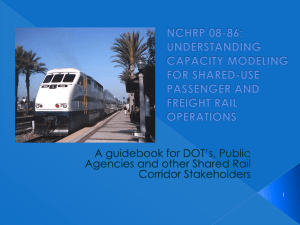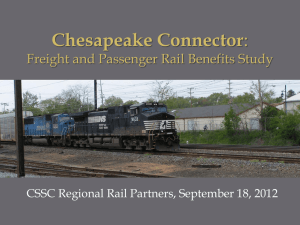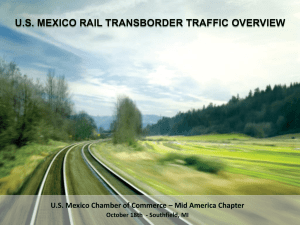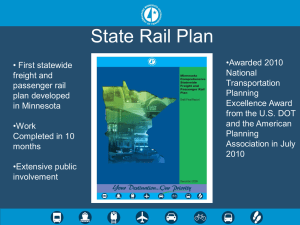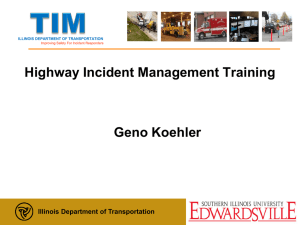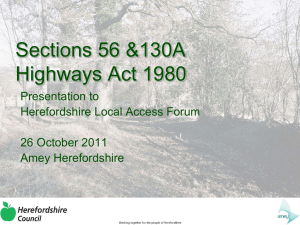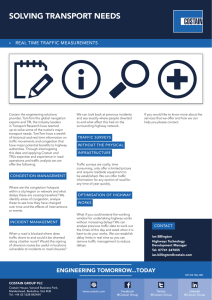Pan-American Highway
advertisement
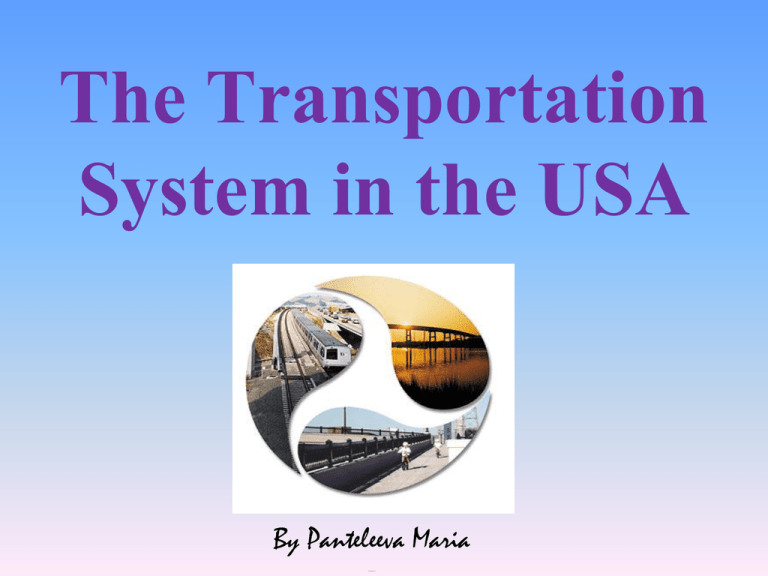
The Transportation System in the USA By Panteleeva Maria And Otegov Alexander Stagecoaches Expansion & settlement into the West created the need for fast, efficient, and economical means of transportation & communication. 1857: Wells, Faro & Company organized a stagecoach service from St. Louis to San Francisco The Pony Express Early 1860s: Wells, Fargo & Company added the Pony Express service – Involved 150 stations stocked with fresh horses – Pony Express guaranteed delivery of a letter from Missouri to California within 10 days! Job advertisement for the Pony Express. Look closely at the requirements. Telegraph Within 18 months of the Pony Express Service, the telegraph was introduced Pony Express was abandoned Pacific Railroad Act, 1862 A route was authorized from Omaha, Nebraska, to San Francisco, California. – Building the railroad could not have been possible without substantial land grants from the US government to the railroad companies • Land grants financed construction • Companies received 120km right of way => 60 km on either side of the rail line • Value of this land increased with the construction of the railway because it was close to the line Development of the US road system The practicality of the automobile was initially limited because of the lack of suitable roads. Travel between cities was mostly done by railroad or waterways. Roads were mostly dirt and hard to travel, especially in bad weather. The Federal Road Act in 1916 allocated $75 million for building roads, and the Federal Highway Act in 1921 provided additional funding for road construction. By 1924 there were 31,000 miles of paved road in the U.S. Federal regulation of the auto industry Safety and environmental issues during the 1960s led to stricter government regulation of the auto industry. This resulted in higher costs and eventually to weaker performance for cars in the 1970s. Seat lap belts were mandated by many states effective in 1962. Federal Motor Vehicle safety Standards initiated in 1968 required shoulder belts for front passengers, front head restraints, energyabsorbing steering columns, ignition-key warning systems, anti-theft steering column/transmission locks, side marker lights and padded interiors. Beginning in 1972, bumpers were required to be reinforced to meet 5-mph impact standards. Emission controls began being instituted in 1968. The use of leaded gasoline began being curtailed in the early 1970s, which resulted in lower-compression engines being used, and thus reducing horsepower and performance. Catalytic converters began being widely used by the mid-1970s. Automobiles 1900: 8,000 automobiles in the US 1920: 8 million cars, 1 million trucks What was the increase in automobiles dependent on? The increase in the importance of the automobile was dependent on the growth of a network of roads. New highways added at a rate of 60,000 km/year => annual cost: $1 billion The rate of transportation expansion and development was exponential Automobiles versus Train 1920s: automobile rivaled the train as a means of passenger transportation. Automobiles soon became more popular than trains for short- and long-distance transportation. Trains continue to be important for longdistance freight transportation Ships In the 19th century water transport was important for the United States, because communications with Europe was essential. The United States was famous for its high-speed clippers vessels with enormous sail rigs. By the second half of the 19th century they were not built anymore. Steamships were built instead. Although in commerce clippers were used up to the first world war. Development of the highway system Just like the railroads, the American government helped finance the development of the highway system. 1956: Federal Aid Highway Act August 13, 1964: President Lyndon B. Johnson signs the Federal-Aid Highway Act of 1964 Role of the government Government involvement in creation of an efficient transportation network is one of the important functions of a government. Transportation changes 1945: changes in transportation patterns since the end of WWII 1940s-1950s – Airports were small – Commercial aircrafts could only carry 2040 passengers 1960s – 1969: 1st American wide-body aircraft Boeing 747 – Carries 500 passengers – 60 million people flew annually Passenger transportation today Passenger transportation in the US is dominated by passenger vehicles (including cars, trucks, vans, and motorcycles), which account for 86% of passenger-miles traveled. The remaining 14% are handled by planes, trains, and buses. Road transportation With the development of the extensive Eisenhower Interstate Highway System in the 1950s, the private automobile became the main mode of transportation for both long-distance trips and the daily commute. The system, the largest expressway system in the world as of 2010, has a total length of 46,837 miles (75,376 km), making it the largest public works project in US history. Maximum speed limits in the United States vary by state from 60 to 80 mph. Road transportation School bus Each day, about 440,000 public school buses transport 24 million children to and from school and school-related activities. Road transportation Intercity bus Greyhound Lines is the largest intercity bus company in the United States, with routes in all parts of the continental U.S.. There are also many smaller regional bus companies, many of which use the terminal and booking facilities provided by Greyhound. Intercity bus is, in most cases, the least expensive way to travel long distances in the US. Road transportation The trucking industry Trucks in America are responsible for the majority of freight movement over land and are vital tools in the manufacturing, transportation, and warehousing industries. Northern section of the Pan-American Highway The Pan-American Highway is a network of roads measuring about 47,958 kilometers (29,800 miles) in total length. Except for an 87 kilometers (54 mi) rainforest break, called the Darién Gap, the road links the mainland nations of the Americas in a connected highway system. According to the Guinness Book of World Records, the Pan-American Highway is the world's longest "motorable road". The idea of the Pan-American Highway emerged at the Fifth International Conference of American States in 1923, where it was originally conceived as a single route. No road in the U.S. or Canada has been officially or unofficially designated as the Pan-American Highway, and thus the primary road officially starts at the U.S.-Mexico border. The original route began at the border at Laredo, Texas and went south through Mexico City. On the other hand, several roads in the U.S. were locally named after the Pan-American Highway. When the section of Interstate 35 in San Antonio, Texas was built, it was named the Pan Am Expressway, as an extension of the original route from Laredo. Interstate 25 in Albuquerque, New Mexico has been named the Pan-American Freeway, as an extension of the route to El Paso. U.S. Route 85, which goes north from El Paso, is designated the CanAm Highway, which continues into Canada in the province of Saskatchewan, before terminating at La Ronge. Rail transportation Passenger trains were the dominant mode of transportation until the mid-twentieth century. The introduction of jet airplanes on major U.S. routes and the completion of the Interstate Highway system accelerated a decline in intercity rail passenger demand during the 1960s, resulting in the sharp curtailment of passenger service by private railroads. This led to the creation of the National Railroad Passenger Corporation (branded as Amtrak) by the Federal Government in 1971 to maintain limited intercity rail passenger service in most parts of the country. Amtrak railway map Rail transportation Cargo The U.S. makes extensive use of its rail system for freight. According to the Association of American Railroads: "U.S. freight railroads are the world's busiest, moving more freight than any rail system in any other country. In fact, U.S. railroads move more than four times as much freight as do all of Western Europe's freight railroads combined." Air transportation The United States has advanced air transportation infrastructure which utilizes approximately 5,000 paved runways. Due to the geography of the United States and the generally large distances between major cities, air transportation is the preferred method of travel for trips over 300 miles (480 km), such as for business travelers and long distance vacation travelers. Air transportation Air cargo Air cargo comprises a large number of daily flights in the United States and cargo flights are operated by private parcel companies such as FedEx and United Parcel Service. These organizations operate some of the largest fleets in the world. Water transportation Water transport in the United States is largely used for freight Freight on the Mississippi River system is carried on barges pushed by approximately 8000 "towboats" and largely consists of bulk goods, such as petrochemicals, grain and cement Many US ports are served by cruise ships. Popular destinations include the Caribbean, the Mexican Riviera, Hawaii and the Inside Passage to Alaska Water transportation Waterways The United States has 25,482 miles (41,009 km) of navigable inland channels (rivers and canals), exclusive of the Great Lakes. Merchant marine Most US exports and imports are on foreign ships. Traffic congestion Traffic congestion, especially at rush hour, is a problem in many of the country's larger cities. A 2010 study found that traffic congestion costs the US almost $87.2 billion. The economic costs of traffic congestion have increased 63% over the past decade, and despite declining traffic volumes, caused by the economic downturn, Americans still waste more than 2.8 billion gallons of fuel each year as a result of traffic congestion. Motorists also waste 4.2 billion hours annually, or one full work week per traveler. Airline glitches top cause of delays Flight delays caused by airline glitches are now creating longer passenger slowdowns than congestion in the skies. The data call into question a long-held notion about air travel delays — that bad weather and heavy air traffic cause the bulk of the waits that passengers endure. The newspaper's analysis shows that airline problems, such as pilot shortages, taking too long to refuel and mechanical breakdowns, are as much at the root of delays as anything else. Unions for pilots and flight attendants said that high turnover and low staffing at regional carriers contributed to delay problems. Airline delays reached record levels this year. New Truck Fuel Efficiency Standards “Trucks represent only 4 percent of vehicles on the road, but they consume 20 percent of the fuel” Union of Concerned Scientists analyst Don Anair points out. The problem is that trucks are complicated: the new rules apply to pretty much everything over 8500 pounds, from the semis that pull long-haul trailers to school buses, fire trucks and pickups. “Miles per gallon" is meaningless when you're hauling different loads. The new rules rely heavily on recommendations by a National Research Council report released earlier this year to divide trucks into three basic categories, and express the fuel standards as "gallons per thousand tons per mile" to take load into account. The standards will be phased in gradually for the 2014 to 2018 model years, and they'll improve fuel efficiency by between 7 and 20 percent, depending on the truck type. That will save 500 million barrels of oil and 250 million metric tons of greenhouse gas, according to EPA calculations. The cost to implement the needed changes: $7.7 billion. Radically Redefining the Airplane The Brilliant Idea: A cleaner, quieter craft with a radical new design, setting the stage for a fundamental shift in aviation. Instead of a single-fuselage cylinder, the D series melds two partial cylinders into a distinctive “double-bubble” shape. This adds to the lift and allows for longer, skinnier wings and a smaller tail, reducing drag. The engines sit at the top rear of the fuselage, where they draw in slower-moving air that passes over the plane, using less fuel for the same amount of thrust—a technique known as boundary layer ingestion. To mitigate the engine stress this creates, the plane would travel about 10 percent slower than a 737; the researchers anticipate making up this time through quicker loading and unloading via the plane’s second aisle. Boeing’s 737 is the best-selling jet airliner in history: Today, it carries 29 percent of all U.S. domestic air traffic and is responsible for 25 percent of the industry’s fuel use. A reinvention of this commercial workhorse, called the D series, could burn 70 percent less fuel, emit 75 percent less nitrogen oxide and dampen noise from takeoffs and landings. In short, it could transform air travel into a more environmentally benign practice. Significant tweaks to the 737’s basic tube-and-wing design add up “like compound interest” on the craft, says MIT aeronautics and astronautics professor Edward Greitzer. The MIT-led team, which includes two commercial partners, developed the D series in response to a $2.1 million NASA research program challenging engineers to design aircraft for 2035, by which time air travel is expected to have doubled. Economic impact According to the U.S. Department of Transportation (DOT): “Transportation’s vital importance to the U.S. economy is underscored by the fact that more than $1 out of every $10 produced in the U.S. gross domestic product is related to transportation activity. This includes all aspects of transportation, including the movement of goods and the purchase of all transportation-related products and services as well as the movement of people”. Employment in the transportation and material moving industry accounted for 7.4% of all employment, and was the 5th largest employment group in the United States. The US invests 0.6% of its GDP on transportation annually.
